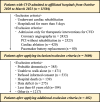Sedentary behaviour may cause differences in physical outcomes and activities of daily living in older cardiovascular disease patients participating in phase I cardiac rehabilitation
- PMID: 38890441
- PMCID: PMC11189532
- DOI: 10.1038/s41598-024-65001-8
Sedentary behaviour may cause differences in physical outcomes and activities of daily living in older cardiovascular disease patients participating in phase I cardiac rehabilitation
Abstract
This study aimed to investigate the rate of sedentary behaviour and differences in physical outcomes and activities of daily living (ADL) based on sedentary behaviour time of hospitalized older cardiovascular disease patients undergoing phase I cardiac rehabilitation. Older cardiovascular disease patients were enrolled from October 2020 to September 2023 and were divided into the high sedentary behaviour group (≥ 480 min/day) and low sedentary behaviour group (< 480 min/day). Patients' clinical characteristics, usual gait speed, and Five Times Sit to Stand Test time were compared as indices of physical outcomes. Motor, cognitive, and total Functional Independence Measure (FIM) scores were used as indices of ADL and compared between groups using analysis of covariance. Final analysis included 402 patients (mean age: 76.7 years, female: 35.3%). The high sedentary behaviour group included 48.5% of the study patients. After adjustment for baseline characteristics, gait speed (0.80 ± 0.27 vs. 0.96 ± 0.23 m/s, p < 0.001) was lower and FTSST time (11.31 ± 4.19 vs. 9.39 ± 3.11 s, p < 0.001) was higher in the high sedentary behaviour group versus low sedentary behaviour group. Motor (85.82 ± 8.82 vs. 88.09 ± 5.04 points, p < 0.001), cognitive (33.32 ± 2.93 vs. 34.04 ± 2.24 points, p < 0.001), and total FIM scores (119.13 ± 10.66 vs. 122.02 ± 6.30 points, p < 0.001) were significantly lower in the high sedentary behaviour group versus low sedentary behaviour group after adjustment. In older cardiovascular disease patients in phase I cardiac rehabilitation, sedentary behaviour time might influence physical outcomes and ADL at discharge. It is thus important to consider the amount of sedentary behaviour time spent by these patients during daily life while hospitalized.
Keywords: Activities of daily living; Daily life; Older cardiovascular disease patients; Phase I cardiac rehabilitation; Physical outcomes; Sedentary behaviour.
© 2024. The Author(s).
Conflict of interest statement
The authors declare no competing interests.
Figures




Similar articles
-
Effectiveness of an intervention to reduce sedentary behaviour as a personalised secondary prevention strategy for patients with coronary artery disease: main outcomes of the SIT LESS randomised clinical trial.Int J Behav Nutr Phys Act. 2023 Feb 14;20(1):17. doi: 10.1186/s12966-023-01419-z. Int J Behav Nutr Phys Act. 2023. PMID: 36788615 Free PMC article. Clinical Trial.
-
Relation of sedentary behaviour to physical function in phase I cardiac rehabilitation.Sci Rep. 2023 Jun 9;13(1):9387. doi: 10.1038/s41598-023-36593-4. Sci Rep. 2023. PMID: 37296206 Free PMC article. Clinical Trial.
-
Effect of home-based rehabilitation on activities of daily living and gait in older adults with heart failure at risk for falling: A retrospective cohort study.Physiother Theory Pract. 2017 Dec;33(12):943-953. doi: 10.1080/09593985.2017.1360422. Epub 2017 Aug 21. Physiother Theory Pract. 2017. PMID: 28825517
-
Interventions for reducing sedentary behaviour in people with stroke.Cochrane Database Syst Rev. 2021 Jun 29;6(6):CD012996. doi: 10.1002/14651858.CD012996.pub2. Cochrane Database Syst Rev. 2021. PMID: 34184251 Free PMC article.
-
Stand When You Can: development and pilot testing of an intervention to reduce sedentary time in assisted living.BMC Geriatr. 2020 Aug 6;20(1):277. doi: 10.1186/s12877-020-01647-z. BMC Geriatr. 2020. PMID: 32762644 Free PMC article. Review.
Cited by
-
Association of sedentary behavior and physical activity with occurrence of signs and symptoms in participants of a cardiac rehabilitation program.Sci Rep. 2024 Sep 30;14(1):22738. doi: 10.1038/s41598-024-74199-6. Sci Rep. 2024. PMID: 39349610 Free PMC article.
-
Focusing on Sedentary Behavior in Comprehensive Cardiac Rehabilitation.Circ Rep. 2024 Oct 5;6(11):481-488. doi: 10.1253/circrep.CR-24-0098. eCollection 2024 Nov 8. Circ Rep. 2024. PMID: 39525298 Free PMC article.
References
-
- Izawa H, Yoshida T, Ikegame T, Izawa KP, Ito Y, Okamura H, et al. Standard cardiac rehabilitation program for heart failure. Japanese association of cardiac rehabilitation standard cardiac rehabilitation program planning committee. Circ. J. 2019;83(12):2394–2398. doi: 10.1253/circj.CJ-19-0670. - DOI - PubMed
-
- Authors/Task Force Members. McDonagh TA, Metra M, Adamo M, Gardner RS, Baumbach A, Böhm M, et al. ESC Scientific Document Group. 2023 Focused Update of the 2021 ESC Guidelines for the diagnosis and treatment of acute and chronic heart failure: Developed by the task force for the diagnosis and treatment of acute and chronic heart failure of the European Society of Cardiology (ESC) With the special contribution of the Heart Failure Association (HFA) of the ESC. Eur. J. Heart Fail. 2024;26(1):5–17. doi: 10.1002/ejhf.3024. - DOI - PubMed
MeSH terms
Grants and funding
LinkOut - more resources
Full Text Sources
Medical

